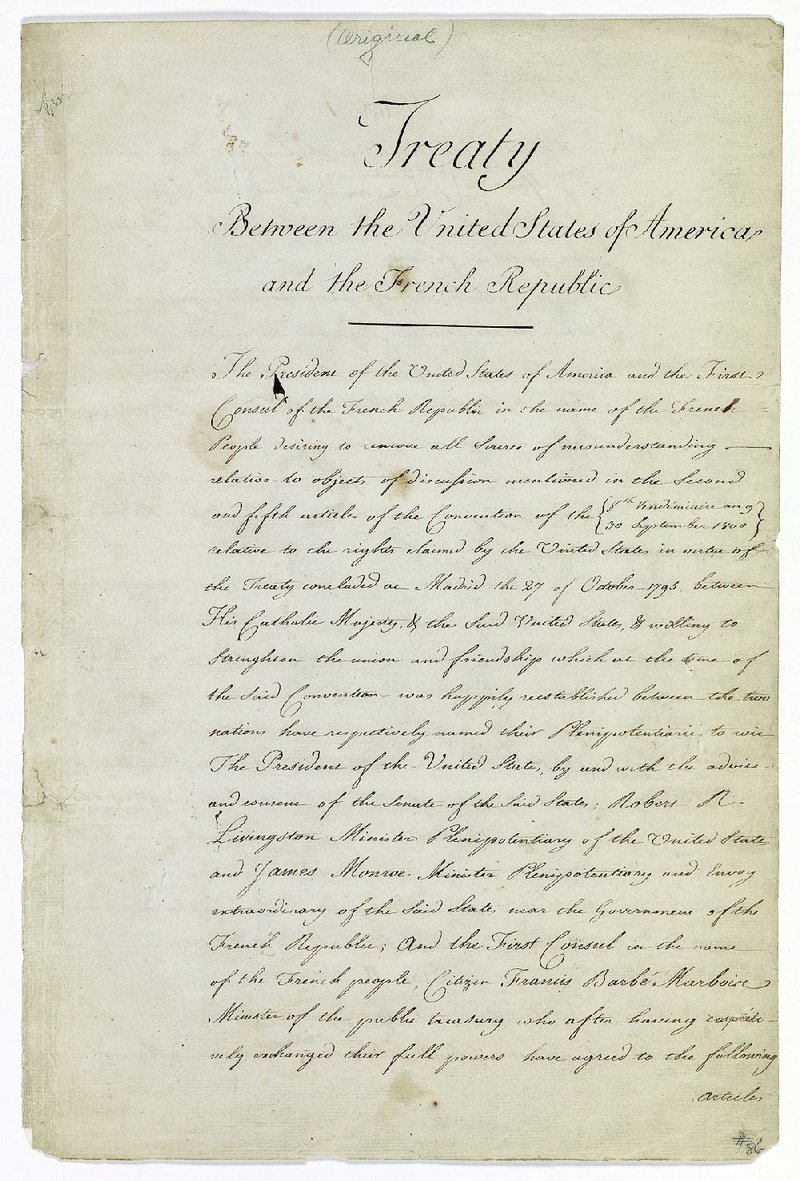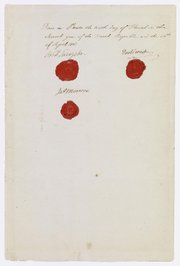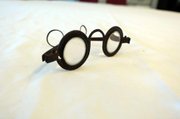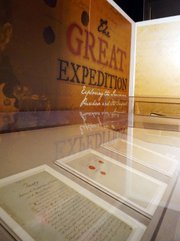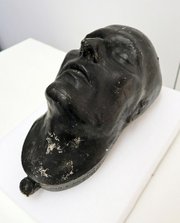Aging pieces of paper. A knife and fork. A portrait of Napoleon.
They seem like disparate items, randomly put together. But they all played a role in one of the most important events in American -- and Arkansas -- history.
“The Great Exhibition: Exploring the Louisiana Purchase and Its Impact on Arkansas”
9 a.m.-5 p.m. Monday-Saturday, 1-5 p.m. Sunday through March 4, Clinton Presidential Center, 1200 President Clinton Ave., Little Rock
Admission: $10; ages 62 and older, college students, retired U.S. military $8; children 6-17 $6; active U.S. military and children under 6 free
clintonpresidential…, wjcf.co/fusion18
(501) 374-4242
"The Great Expedition: Exploring the Louisiana Purchase and Its Impact on Arkansas" is the Clinton Presidential Center's newest exhibit, an examination of what was, in essence, an epic real estate deal.
In 1803, Napoleon Bonaparte, who was then France’s “first consul for life,”* was in need of more money to finance his European wars. The still-young United States was anxious to get control of the land west of the Mississippi River. So, in late spring of that year, America bought the Louisiana Territory, about 828,000 square miles that included present-day Arkansas, from France for $15 million.
In that defining moment, the country doubled in size and westward expansion became a reality.
The exhibit is part of the Clinton Center's Fusion: Arts + Humanities Arkansas program. It's based on a similar program in Texas that, in a world where science and technology are taking a lead in education, shines a stronger light on a different aspect of learning.
Clinton Center spokesman Rebecca Tennille explains, "Not to take away from the importance of STEM [Science Technology Engineering and Mathematics], but it's just to focus on the arts and humanities as well."
The center's main exhibit spaces were already taken with "Art of Africa: One Continent, Limitless Vision" and "Mandela: The Journey to Ubuntu," both of which have since closed.
Ben Thielemeier, Clinton Foundation communications manager, says, "We don't have a lot of specific gallery spaces outside the two. So, how can we creatively use other spaces?"
They turned to the small, circular theater where the center's orientation video usually plays on a loop and turned it into a temporary gallery. For now, the video plays out in the hall. The video screen and half the theater seats are hidden behind information panels and display cases.
It turns out, this windowless, interior room is perfect for this small but historically giant exhibit.
Archivist Stephanie Sims says, "The artifacts, they're sensitive to light, of course. We just decided to bring everything inside."
Actual Louisiana Purchase documents, on loan from the National Archives and Records Administration are:
• The American original of the sale treaty, signed by U.S. diplomats Robert Livingston and James Monroe and by French Finance Minister Francois de Barbe-Marbois.
• The exchange copy of the convention for payment of money due to U.S. citizens signed by Napoleon.
• The American original of the convention for payment of 60 million francs ($15 million).
This exhibit's run is only about a month, shorter than other center exhibits and the documents' fragility is the main reason.
Kurt Senn, deputy director of the William J. Clinton Presidential Library says, "There's a formula we use on all sensitive textiles, how many days they can be exhibited. It's calculated on the amount of light exposure and climate exposure."
The documents are among the archive's "100 Milestone Documents" and normally stay in Washington.
Senn says, "NARA [National Archives and Records Administration] made a concerted effort in the last couple of years to make sure these kind of documents can make it out to other places and make them more accessible, which isn't easy considering their age and how fragile they are."
They may be the most historically significant, but they're not the only items on display in the exhibit.
There's also a portrait of Napoleon and his death mask, both on loan from the Tennessee State Museum's Tennessee Historical Society Collection. They rest on a wall and in a case just a few short feet from the document bearing his signature.
Another case displays eating utensils, an 18th-century 3 livre banknote and an 1807 book by Lewis and Clark, from the Historic Arkansas Museum and the Arkansas State Archives.
On another wall, there's a case and panels dedicated to a lesser-known part of the Louisiana Purchase story, but a part that's highly significant to Arkansas.
The Lewis and Clark Expedition is well-known and well-documented. The epic trek from the Mississippi River to the Pacific Ocean has captured the attention of historians, naturalists and adventurers for more than 200 years. But their trip wasn't the only expedition sent out by President Thomas Jefferson after the Louisiana Purchase.
Jefferson sent multiple parties out to create detailed scientific reports on and maps of the vast new territory.
Zebulon Pike explored the Rocky Mountain and southwest regions. Thomas Freeman and Peter Custis traveled the Red River. And William Dunbar and George Hunter were sent to what is now Arkansas and Louisiana to explore the Ouachita and "the boiling springs."
Lewis and Clark covered nearly 8,000 miles over the course of about three years. Dunbar and Hunter's journey took a little over three months. But they turned in the first and most detailed scientific report on the Ouachita River Valley, its inhabitants, plant and animal life.
The exhibit has several items from the Hunter-Dunbar Expedition. There's a compass, a pair of spectacles and Dunbar's handwritten journal, all on loan from Ouachita Baptist University.
At the center's front entrance, a keelboat looks right at home in the center's fountain. The Aux Arc, on loan from the Early Arkansaw Reenactors Association, is a 40-foot replica of the boat used in the Dunbar-Hunter expedition.
"The fact that we actually have local history with the Hunter-Dunbar [expedition] is great for people to learn about," Sims says. "That we have this type of history in our own backyard."
The exhibit's information panels are extensive, giving the history of the Louisiana Purchase and explaining its importance to Arkansas and to the country as a whole.
The center's exhibit has drawn a lot of attention, particularly from local school groups. When it was first announced at a special teachers' day last summer, it generated a good bit of excitement.
Sims remembers, "Everybody was like, 'Where can I sign up? I want to bring my students.' Once the word was out, they started pouring in, which is exciting."
It is a small but eclectic collection and, to the best of everyone's knowledge, the various pieces have never been together in the same room before.
"I can't think why they would have ever been in the same place," Senn says. "The NARA doesn't [loan] their most important documents a whole lot."
Tennille says, "It's not just the [Louisiana] Purchase, though that's super-cool. It's the death mask. It's a nice, very unique grouping that probably will not be together again."
That leaves a narrow window for people to see all the pieces of the puzzle together. And, since this is an in-house exhibit, Little Rock is the only place to see it.
Sims says, "It's a great place to set your eyes on something most people actually travel hundreds of miles away to see."
That, Tennille explains, is part of the Clinton Center's mission: "[President Bill Clinton] wanted to put [the center] here in Little Rock, one, because he wanted to thank the people of Arkansas, but two, he wanted something in the middle of the country that people would have access to. So you didn't have to go to a coast.
"This is how we're bringing history here to fulfill his vision for his center."
Style on 02/20/2018
*CORRECTION: At the time of the Louisiana Purchase in 1803, Napoleon Bonaparte was France’s “first consul for life.” He declared himself emperor the following year. A previous version of this story incorrectly identified his title at the time of the sale.

